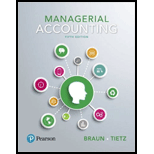
Determine transfer price at a manufacturer under various scenarios (Learning Objective 4)
Assume the Small Components Division of Lang Manufacturing produces a video card used in the assembly of a variety of electronic products. The division’s
| Cost per unit | |
| Direct materials | $ 14.00 |
| Direct labor | $ 4.00 |
| Variable manufacturing |
$ 8.00 |
| Fixed manufacturing overhead (at current production level) | $ 9.00 |
| Variable selling expenses | $ 10.00 |
The Computer Division of Lang Manufacturing can use the video card produced by the Small Components Division and is interested in purchasing the video card in-house rather than buying it from an outside supplier. The Small Components Division has sufficient excess capacity with which to make the extra video cards. Because of competition, the market price for this video card is $30 regardless of whether the video card is produced by Lang Manufacturing or another company.
Requirements
- 1. What is the highest acceptable transfer price for the divisions?
- 2. Assuming the transfer price is negotiated between the divisions of the company, what would be the lowest acceptable transfer price? Assume variable selling expenses pertain to outside sales only.
- 3. Which transfer price would the manager of the Small Components Division prefer? Which transfer price would the manager of the Computer Division prefer?
- 4. If the company’s policy requires that all in-house transfers must be priced at full absorption cost plus 14%, what transfer price would be used? Assume that the increased production level needed to fill the transfer would result in fixed manufacturing overhead decreasing by $3.00 per unit. (Round your answer to the nearest cent.)
- 5. If the company’s policy requires that all in-house transfers must be priced at total manufacturing variable cost plus 18%, what transfer price would be used? Assume that the company does not consider fixed manufacturing overhead in setting its internal transfer price in this scenario. (Round your answer to the nearest cent.)
- 6. Assume now that the company does incur the variable selling expenses on internal transfers. If the company policy is to set transfer prices at 102% of the sum of the full absorption cost and the variable selling expenses, what would the transfer price be set at? Assume that the fixed manufacturing overhead would drop by $3.00 per unit as a result of the increased production resulting from the internal transfers. (Round your answer to the nearest cent.)
Want to see the full answer?
Check out a sample textbook solution
Chapter 10 Solutions
Managerial Accounting, Student Value Edition Plus MyLab Accounting with Pearson eText -- Access Card Package (5th Edition)
- Provide answer this following requirements on these general accounting questionarrow_forwardGlendale Manufacturing has a profit margin of 6%, a 40% dividend payout ratio, a total asset turnover of 1.5, and an equity multiplier of 1.6. What is the sustainable growth rate?Solve thisarrow_forwardDuring May, Schultz Company produced 12,000 units of a product called Premium. Premium has a standard materials cost of three pieces per unit at $6 per piece. The actual materials used consisted of 35,000 pieces at a cost of $175,000. Actual purchases of the materials amounted to 45,000 pieces at a cost of $225,000. Compute the two materials variances.arrow_forward
- ?!!arrow_forwardWhich of the following choice is the correct status of manufacturing overhead at year end ?.arrow_forwardMadison Corporation began 2025 with $24,000 in stockholders' equity. Of this amount, $15,000 was in common stock, and there were no changes in the common stock account during 2025. At December 31, 2025, Madison had $28,000 in stockholders' equity. Madison paid out $9,000 in dividends during the year. How much was its net income in 2025? correct answerarrow_forward
 Cornerstones of Cost Management (Cornerstones Ser...AccountingISBN:9781305970663Author:Don R. Hansen, Maryanne M. MowenPublisher:Cengage Learning
Cornerstones of Cost Management (Cornerstones Ser...AccountingISBN:9781305970663Author:Don R. Hansen, Maryanne M. MowenPublisher:Cengage Learning Excel Applications for Accounting PrinciplesAccountingISBN:9781111581565Author:Gaylord N. SmithPublisher:Cengage Learning
Excel Applications for Accounting PrinciplesAccountingISBN:9781111581565Author:Gaylord N. SmithPublisher:Cengage Learning

